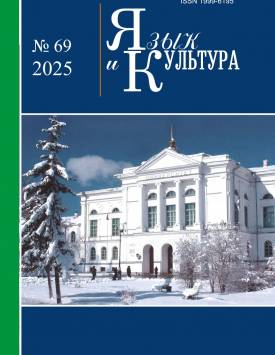The discourse of translation portraiture
The article introduces a new kind of special discourse - the discourse of translation portraiture, interpreted by the authors as a cognitive-communicative event that takes place in the translation and meta-translation space formed in the mind of the translator as an active, thinking, creative subject. The professional activity of a translator as an elite linguistic personality with a harmonious worldview and generating quality texts is aimed at establishing interlingual and intercultural contacts, mutual understanding and interaction of communicators belonging to different linguocultures. The research is based on the idea of creating portraits of translators, first realised by the Canadian scientist J. Delille. The object of the study is the personological space of language and culture. The subject of the study is the linguistic personality of the translator. The main aim of the article is to substantiate the necessity of theoretical comprehension and practical realisation of the discourse of translation portraiture. In order to achieve this goal, the following research tasks were solved: identification of the role and place of the discourse of translation portraiture in modern discourseology, development of an algorithm for describing portraits of Russian translators, creation of a portrait of an outstanding Russian writer and poet, Nobel Prize winner in Literature Boris Leonidovich Pasternak, who left a rich translation heritage. The paper summarises and systematises the scientific prerequisites for the development of the discourse of translation portraiture, which form independent areas of translation discourse in the works of Russian researchers. The material for the analysis is texts about Russian translators, devoted to the description of their life and creative path, professional activity in various fields, including translation activity: the choice of translation strategies, text types, translated languages; the nature of translation reflection; memoir studies, interviews, etc. Due to the fact that we are interested in the linguistic personality of B.L. Pasternak, his literary and translation work, which represents the best examples of the twentieth century, serves as the material of the research within the framework of this article. At present, an independent area of research is being formed - the discourse of translation portraiture: theoretical and empirical information is being accumulated, portraits of other Russian translators are being created, their role in national and world literature and culture is being revealed. The hypothesis formulated for this study is that the discourse of translation portraiture is a hybrid type of discourse, as it emerges at the intersection of various scientific concepts: discourse studies, lin-guopersonology, the theory of translator's linguistic personality, translation theory, translation criticism and others. The main methodological tool is L.V. Kushnina's concept of translation space, according to which translation is understood as a synergetic system of transposing heterogeneous meanings from one linguoculture to another. Based on the concept of epistemic situation introduced by M.P. Kotyurova, in the previous works we substantiated the concept of translation episteme, including ontology, methodology, and axiology. The ontology of translation activity is based on the translator's cognitive efforts, the methodology is based on the synergetic increment of culturally determined meanings in the translation discourse, and the axiology is determined by the generation of a harmonious translation discourse, the meanings of which are commensurate with the meanings of the original discourse. The research resulted in the creation of ‘touches' to the portrait of Pasternak the translator, as the creation of a full -fledged portrait of the translator, an outstanding representative of Russian literature, requires extensive research. It was concluded that the algorithm proposed by the authorsfor creating a portrait of a translator can be used to describe portraits of other outstanding Russian translators. The authors declare no conflicts of interests.
Keywords
linguistic personality of the translator, portrait of the translator, portrait discourse, translation space, synergy, harmony, cognitionAuthors
| Name | Organization | |
| Kushnina Lyudmila V. | Perm National Research Polytechnic University | lkushnina@yandex.ru |
| Khabibrakhmanova Farida R. | Perm National Research Polytechnic University | faridhin@mail.ru |
| Pogorelaya Nina G. | Perm National Research Polytechnic University | npogorelaia@yandex.ru |
References

The discourse of translation portraiture | Yazyk i Kultura – Language and Culture. 2025. № 69. DOI: 10.17223/19996195/69/2
